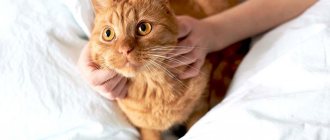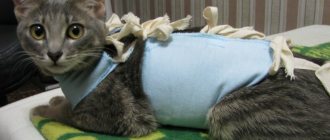- What can an owner do to help a cat during childbirth?
- What to do after giving birth to a cat?
Childbirth in a cat is a natural process that ends pregnancy and involves the fetus leaving the uterus through the cervix and vagina (birth canal).
First birth of a cat
As a rule, experienced cats themselves know what to do. But if a cat gives birth for the first time, problems may arise, since the cat does not have a good idea of what is happening to it. And in order to know how to help a cat give birth for the first time, you need to understand that childbirth is a lot of stress for a cat.
The first birth of a cat: what should the owner do? First of all, you need to prepare a cozy place for childbirth in advance. As a rule, a spacious box serves as a delivery room, and the sides should not be too high so that the cat can easily get inside. The “birthing room” should be located in a quiet, secluded place.
Also, to help your cat give birth for the first time, you need to prepare:
- Surgical gloves.
- Cotton buds.
- Sharp scissors.
- Clean cloth (cotton) or diaper.
- Clean towels (terry).
- Cotton buds.
- Gauze or cotton swabs.
- Boiled thread.
- Powdered milk formula (from a veterinary pharmacy or pet store).
- Pipette or rubber bulb.
- Syringe.
- Container for used materials.
- Liquid antiseptic (veterinary).
- Antibiotic ointment.
It is better to put everything you need in one place in advance (about a week before the expected date of birth). And don’t forget to put in a visible place the phone number of a veterinarian who can tell you what to do or come if necessary.
Search for a place
A place for a woman in labor can be arranged on a bed or using a tray. The most suitable option is a cardboard box, the bottom of which is covered with paper. Qualities that a birthing place must meet:
- The box should be closed, but large in size, since the animal will live there with the kittens for several months.
- For convenience, one wall of the box is cut off. This will allow the cat to freely enter the bed area without jumping over the barrier each time.
- The prepared house is installed in a quiet place, closed from prying eyes. This could be the bathroom, a corner of the room behind the sofa, or a closet.
If the cat ignored the chosen place and hid in the closet, this is an indicator that it lacks silence and feels unprotected.
Cat before giving birth
Many owners ask how their cat behaves before giving birth. This is necessary to know in order to prepare for the cat’s birth and not miss its beginning.
What does a cat do before giving birth?
A few hours before giving birth, the cat begins to show anxiety. From this moment on, it is better to stay nearby in order to provide assistance to your pet if necessary.
Active washing, as the cat’s genitals increase in size and turn pink. The cat should not have any discharge before giving birth.
Decreased activity. Before giving birth, the cat's behavior becomes apathetic and detached, she looks bored. Don't try to entertain her.
Decreased appetite. Water must continue to be available at all times.
Arching as during contractions. This trait of a cat's behavior before giving birth is explained by short contractions of the uterus.
Also, a cat before giving birth may behave somewhat unusually: meow loudly, seem scared, try to hide in a secluded corner. Therefore, a few days before the expected date of birth, block the cat’s access to hard-to-reach places.
What can the owner do to ease the cat’s condition before giving birth: be nearby, stroke if the cat allows it, talk in an even, gentle voice.
How does a cat give birth?
Another common question from owners is how to tell if a cat is in labor. The beginning of labor in a cat is marked by contractions - contractions of the uterus. Contractions in a cat begin several hours before the kittens appear and increase gradually. You should take your cat to the delivery room and prepare everything you need.
Signs of labor in a cat
Owners often ask what are the signs that a cat is going into labor. The following signs will help you understand that your cat is about to give birth:
- The cat's belly takes on a pear-shaped shape - it drops.
- The cat goes to the toilet more often due to a more frequent urge to urinate.
- The birth plug comes off and mucus is released.
- The water breaks, and the cat licks itself thoroughly.
- Breathing becomes more frequent and shortness of breath is possible.
As a rule, the first kitten is born within 2 hours after the cat begins strong contractions. If the cat pushes for 3 hours or more without success, or brown discharge with an unpleasant odor appears from the vulva, immediately take the cat to the veterinarian. Surgery may be necessary.
How to properly feed a cat that has given birth?
As soon as you find out that your pet is pregnant, it is extremely important to provide her with the highest quality feeding and housing conditions. It is highly advisable that before the planned mating, the cat has already received all the vaccinations it needs.
During pregnancy, vaccination is strictly prohibited. In addition, make sure that your pet does not have parasites.
To do this, you need to provide a sample of the animal's stool to a veterinary clinic. Many types of parasites are microscopic in size, and therefore you cannot see them with the naked eye.
Remember that from about the 20th day of pregnancy, the cat's need for nutrients gradually increases. Immediately after birth, nothing changes, since the pet’s body requires resources to restore itself and feed the offspring. We highly recommend avoiding dry food: canned diets specifically designed for feeding pregnant and lactating cats are ideal. They should be given until the kittens are completely weaned.
If there are no appropriate recommendations from a veterinarian, do not give your animal any vitamins!
Remember that an excess of them is many times more dangerous than a lack. In addition, it has been repeatedly proven that excessive amounts of vitamins contribute to the development of anatomical pathologies in the structure of kittens, which is why subsequent births will either be delayed or even end in the death of the mother herself.
How long does it take for a cat to give birth?
Another popular question from cat owners is: how long does it take for a cat to give birth?
The duration of labor in a cat should normally not exceed 12 - 18 hours (from the moment the first kitten appears).
If a cat's labor lasts longer, this is a bad sign. If the duration of labor (from the first to the last kitten) takes more than 24 hours, this is also a sign of pathology and a reason to seek help from a specialist.
If a cat’s labor lasts more than 48 hours, the probability of getting live kittens is almost zero. To save a cat and kittens, surgery is most often needed in such cases.
Birth complications (Pathology of childbirth)
It happens that a poor animal cannot give birth to a single kitten, although a long time has passed since the beginning of the second period (breeding contractions). The muscles on the cat's sides contract at regular intervals, the cat loses strength, and the baby is never born.
Birth complications may occur if:
- breech birth (the kitten moves its butt forward along the birth canal, and not its head, as expected);
- fetal head torsion or tilting back;
- discrepancy between the size of the fetus and the cat’s pelvis;
- transverse presentation of the fetus;
- Two kittens entered the birth canal at once.
Kittens are born in strict order: first, the first kitten appears from the first horn of the uterus, then the second from the second horn, the next one again from the first, etc. Sometimes you come across ignorant people who try to go along with the “queue”, then complications are possible and the help of a doctor is necessary.
The pathology of childbirth may be associated with dysfunction and abnormalities of the genital area:
- narrowness of the vulva or vagina;
- narrowing of the cervical canal;
- dry mucous membrane;
- spasms;
- weak or excessively violent contractions.
Giving birth to a cat at home
It is useful for owners to know how to organize the birth of a cat at home and how to help a cat during birth at home.
What can an owner do to help a cat during childbirth?
First of all, closely monitor the birth and keep the veterinarian's phone number handy. If you see that something is wrong (for example, if the first kitten does not appear within 7 hours of the onset of strong contractions), seek professional help as soon as possible.
Stay calm and, no matter what happens, do not scream or flash in front of the cat's eyes. Ask that no one else enters the room until the cat gives birth. Talk to your cat calmly and affectionately.
How to deliver a cat
Another popular question from owners: how to deliver a cat? Make sure that when giving birth to a cat at home, the placenta does not remain inside the animal. The placenta remaining inside can cause an inflammatory process.
Please note that after each kitten there is an afterbirth, which the cat usually eats. But don't let your cat eat more than 2 afterbirths - this will cause digestive upset.
If the kitten begins to breathe inside the bubble, it may stop breathing. Take the kitten (carefully!) in your hand, lower the head down a little so that water flows out of the spout. If that doesn't help, shake your baby a little. Make sure your breathing is normal. The kitten's tongue should be pink. If he turns blue, wrap the baby in a diaper and hold him upside down for a while. As soon as the kitten squeaks, it can be given to its mother.
If your cat does not chew the umbilical cord, your job is to cut the umbilical cord for her. Pull the umbilical cord with a thread (about 2 cm from the kitten’s tummy) and cut it with disinfected scissors, wipe the cut area with an antiseptic.
Dry the babies with a soft diaper and place them on a heating pad covered with a bedding.
As a rule, after the birth is complete, the cat looks relaxed and peaceful and begins to feed the kittens. At this point, the best thing you can do to help your cat give birth is to leave her alone, after changing the bedding. Make sure your cat has food and water in his bowl. Keep other animals away from your children, including a cat if it lives in your house.
How does this happen?
After the first contractions have occurred, you need to understand that the process is nearing its end. But before active labor and immediate pushing, the pet will have to endure a lot. In general, it is convenient to divide what is happening into several stages:
- Opening of the birth canal and cervix (if the cat’s water breaks, this indicates the onset of labor).
- Birth of kittens (the birth interval for each of the litter's cubs is normally from 15 minutes to half an hour).
- Exit from the uterine cavity of the placenta.
Before you give birth to a cat, you need to prepare additionally. Definitely, you need to be prepared for the fact that you may need additional materials and simple pharmaceuticals. Before labor begins, it is important to have on hand:
- clean gauze;
- pipette;
- petrolatum;
- scissors;
- heating pad;
- towel.
Initial stages of labor
You should not rule out the possibility that you will have to call a veterinarian if something goes wrong. Labor in cats usually lasts about 12 hours. As with women, the first time for furry pets often takes a long time and is much more painful. The initial stage can make up most of the entire period of labor.
Contractions cause discomfort in the animal, it begins to breathe quickly and behave restlessly. But it is important to know that it is absolutely forbidden to shout at a cat in such a state, no matter what it does. It is necessary, first of all, to calm the pet down and give it the opportunity to feel protected.
How to help a cat in case of weak labor?
When labor does not activate for quite a long time, especially if the cat’s water broke about 30 minutes ago, it is urgent to take serious action and induce labor. This should be done without unnecessary hesitation, however, even a chaotic rush can only harm the pet.
Here's how you can help your cat:
- The owner's fingers should be lubricated with Vaseline.
- Gently insert your fingers into the vagina and begin to slowly pull out the kittens.
- The cat's belly must be supported with your free hand.
- If the contraction stops, it is important to massage the back and stroke the stomach, stimulating the appearance of new attempts.
- Under no circumstances should you pull the kitten by the head. Otherwise, you can break his cervical vertebrae, which, naturally, will lead to death.
It is not difficult to induce labor, but it is advisable to resort to such a procedure only in exceptional cases.
Immediate birth of babies
Cat birth moves to the next stage when the amniotic sac ruptures. The discharge of amniotic fluid helps to lubricate the vaginal passage. Usually a few minutes pass between the rupture of the amnion and the birth of the first baby. All cats have completely different durations for such breaks: for some, everything goes away in 5 minutes, while other animals give birth to their kittens in up to half an hour. But it is important to know that the time interval between the birth of the remaining cubs should not exceed a 30-minute pause.
A cat gives birth to kittens within 2-4 hours. Then a completely natural process continues, which does not require any human intervention. There is no need to do anything, because on an instinctive level the animal itself must accept its offspring. The mother quickly licks the face of each kitten as each of them is born, gnaws the umbilical cord and removes the amniotic membranes.
The third and final stage of labor involves the separation of the placenta, which comes out on its own a few minutes after the kitten is born. Many owners may not know that cats usually eat placenta. In addition, after such “food”, young mother cats may develop gastrointestinal upset.
How many kittens can a cat give birth to?
Another logical question from owners: how many kittens can a cat give birth to at one time (the first time or the maximum number)?
As a rule, for the first time a cat can give birth to 1 – 3 kittens, since the cat’s reproductive system is not fully formed. Older cats also give birth to a small number of kittens - their reproductive function fades.
How many kittens can a cat in her prime give birth to at one time? Typically up to 6 kittens. After all, nature has endowed a cat with only 8 nipples, which means that it is difficult for a cat to feed more than 8 kittens.
However, there are exceptions. No one knows exactly how many kittens a cat can give birth to, but there have been recorded cases of the birth of 12 kittens.
Stages of kitten birth
The birth process is usually divided into stages:
- The long stage is contractions.
- The middle stage is attempts and expulsion.
- The short stage is the expulsion of the placenta.
Labor begins with contractions. The uterus begins to contract, pushing the kittens into the cervix. Under pressure, the neck begins to expand. At this stage, a clear discharge appears from the cat's vagina. Less often and during rapid labor, a large volume of water comes out at once.
Important! The process of contractions, normally, can take from 10 to 12 hours. During prolonged labor, 24 hours may pass before pushing occurs.
Cat after birth
What to do after giving birth to a cat?
This is also a popular question among owners. The birth can be considered complete if, 1.5 - 2 hours after the birth of the last kitten, the cat has no contractions, the stomach is soft and all the placenta have come out. During this period, the main thing is to feed the cat properly and protect it from stress.
If the birth took place without complications, as a rule, after 14 days the cat recovers completely, and the kittens grow significantly.
When can a cat become pregnant after giving birth?
Owners often ask how quickly a cat can become pregnant after giving birth and can a cat become pregnant immediately after giving birth? It must be taken into account that giving birth and feeding kittens is a huge burden on the cat’s body, which exhausts the animal and can lead to diseases.
So after giving birth, the cat needs a recovery period. On average, a cat comes into heat 1 – 2 months after giving birth. But even if the cat is ready to become pregnant immediately after giving birth and begins to ask for a cat, take measures to prevent pregnancy from occurring.
The maximum number of births a cat can give birth to is once a year. In this case, the cat has the opportunity to recover from previous births and raising kittens.
When can a cat be spayed after giving birth?
Sometimes owners are interested in whether it is possible to sterilize a cat after giving birth and when can a cat be sterilized after giving birth? Veterinarians cannot answer this question unequivocally. The answer to the question of how long to sterilize a cat after giving birth depends on whether the cat is nursing kittens. If your cat is nursing kittens, you should not spay her immediately after giving birth. As a rule, veterinarians say that a cat can be sterilized no earlier than 2 months after birth. Sterilizing a cat after birth is fraught with serious complications (including death) and is possible only in exceptional cases.
The cat does not have milk after giving birth
There are several reasons why a cat does not produce milk after giving birth:
- Stress.
- Infection. In this case, treatment with antibiotics is necessary.
- Lack of maternal instinct - occurs, as a rule, in a young cat.
- Poor nutrition. Give your cat more dairy products, vitamins and protein.
- Hormonal imbalance.
In any case, you need to contact a specialist and follow his recommendations.
What to feed a cat after giving birth
Many owners are concerned about the question of what to feed their cat after giving birth. How to feed a cat that has given birth?
During the first 10 to 12 days after birth, the diet of a nursing cat should include only nutritious, natural and easily digestible foods: fermented milk, cereals and vegetables. If your cat really lacks meat, you can give boiled dietary meat.
It is better to exclude dry food: a large amount of salt and a small amount of liquid makes it difficult for a cat to produce milk after birth. However, if a cat has allergies, a sudden change in diet is contraindicated. In other cases, familiar foods are introduced into the diet of a nursing cat on the 14th day. Please note that after giving birth, your cat needs to be given foods that contain magnesium and calcium. Ask your veterinarian which supplements to choose. It is important that food for a nursing cat is always fresh. Water must be freely available.
Brief information about a normal pregnancy
Many breeders sincerely assume that pregnancy should be considered the period from mating to the birth of kittens, but this is not entirely true. In fact, pregnancy should be considered the interval from conception (which can occur several days after mating) until the birth of the offspring . It is believed that the normal average gestation period for cats is approximately 63 days (i.e., about two months).
Please note that identifying the exact time of conception can be very difficult. We have already written above that it can occur several days after mating (this happens because the cat’s sperm remains viable in the genital tract for some time). Therefore, it is believed that from mating to the birth of kittens can take from 58 to 70 days. It is for this reason that it is recommended to show a pregnant pet to a veterinarian: an experienced specialist in a well-equipped clinic will be able to accurately determine the gestational age.
The older the cat, the less likely it is that she will be able to become pregnant at the first contact with the cat. To know for sure whether your pet is pregnant, you need to take her to a veterinary clinic that practices ultrasound pregnancy diagnosis.
The cat can't give birth
Normal birth in a cat lasts no more than 18 hours. If the process is delayed, it means that the cat cannot give birth normally. What to do if the cat cannot give birth?
First of all, seek help from your veterinarian. There are many reasons for birth pathologies, and only a specialist can properly help your pet.
If 24 hours have passed since the start of labor and the cat is still unable to give birth, the kittens are most likely dead. And in this case, surgery is necessary. But first, X-ray diagnostics may be needed.
The main rule: if you see that something went wrong during the cat’s birth, contact your veterinarian as soon as possible!
Signs that indicate the onset of labor
1–3 days before the onset of labor, you can understand from the cat’s behavior that this moment will soon come:
- The future tailed mother is actively looking for secluded places, every now and then trying to hide in the closet or behind the sofa. Digs there, trying to build a nest. The pet becomes very affectionate, constantly demands attention, and can sometimes be annoying. It rarely happens that a cat, on the contrary, becomes overly aggressive and hides from its owners. Other symptoms:
- at this time, the loop increases greatly, and clear or light pink discharge is observed;
the cat begins to lick itself more often;
- There is a loss of appetite up to complete refusal of food.
- When there are a day or a little less left before lambing, the animal’s body temperature drops to 37°C.
- 4–8 hours before lambing, the animal begins to hunch over. This is how the body reacts to training contractions of the uterus. This process causes great anxiety in the pet; she may complain to the owner, seeking his support. But another option is also possible - she will try to hide.
- 4 hours before labor, the mucus plug comes off. It is a small transparent clot, sometimes it can have a yellowish or greenish tint and include small inclusions of brown, which is considered normal. Often the plug comes out during urination or in parts. But this moment may not be noticed in an overly clean animal.
- When the temperature rises to normal—38–39°C—this means that there are about 2 hours left before birth.
1–3 days before giving birth, the cat persistently demands attention and affection
If a cat experiences premature lambing, then the described symptoms occur almost 2 times faster.
Call a veterinarian immediately if:
- a furry pet carries kittens longer than expected;
- the pet experiences fever, vomiting and convulsions;
- bleeding lasts more than 10 minutes and is accompanied by an unpleasant odor.
Video: signs of the beginning of lambing
Premature birth
Sexual infections, physical trauma, and severe stress are some of the main causes of premature lambing. This problem can occur in older cats or in representatives of breeding and selective breeds who are giving birth for the first time.
Be sure to show your pregnant cat to a veterinarian, and before giving birth, agree with him about help if necessary.
If lambing occurs when the gestation period is 51 days or more, the kittens are considered viable and must be fought for their lives. Call your veterinarian immediately. But under no circumstances try to stop contractions in order to postpone labor until a specialist arrives. You will have to deliver the baby yourself.
If the premature birth was successful and the cat feels fine, still show her to a specialist.
How to behave with a pet
If this is your first time attending the birth of a family pet, then excitement is a natural process. You must understand that when a furry mother goes into labor, she experiences pain, fear and needs support. Your behavior will largely determine the successful outcome of the case. Even if you don’t really understand how to act, control yourself. Get together and provide all possible assistance:
- Try to ensure that no strangers or curious people gather near the lambing area.
- Apart from the owner, there should be no other people in the cat's field of vision, even if they are family members to whom the cat is accustomed.
- Talk kindly to your pet, show her that you are nearby and will not abandon her in difficult times. Stroke it from top to bottom. Speak kind words.
Your participation will calm the cat before giving birth
‼ Reason to contact the veterinarian ‼
- If the cat begins to give birth earlier than 55 days later, or 65 days have already passed and labor has not begun.
- If more than an hour has passed since the cat gave birth to the last kitten, and you see by the stomach that not all kittens were born.
- If after lambing there is scarlet bleeding.
- If clots of mucus with dried blood appear from the cat's birth canal. This indicates the death of one of the kittens and requires immediate assistance.
- If the cat suffers for an hour, but still begins to give birth.
- If, after a day, the cat has a temperature of about 40 degrees, she does not eat anything and is exhausted.
How to understand that the moment of birth is near
A couple of days before a significant event, the animal’s behavior changes. The cat becomes restless and tries to hide in some secret place.
This is a normal phenomenon : the cat exhibits a nesting instinct, and she looks for a calm, secluded place where she will give birth to offspring.
Help the animal find a “shelter” if you don’t want kittens to appear in some hard-to-reach place. A box with a cloth placed on the bottom is best suited for these purposes. It should not be too small and not have a strong odor.
Place the box in some secluded place so that household members do not disturb the newborns and their mother again. Perhaps the cat will leave the new shelter. It means you did something wrong.
Other signs are frequent walking and refusal to eat, which appear in the last hours of pregnancy.











